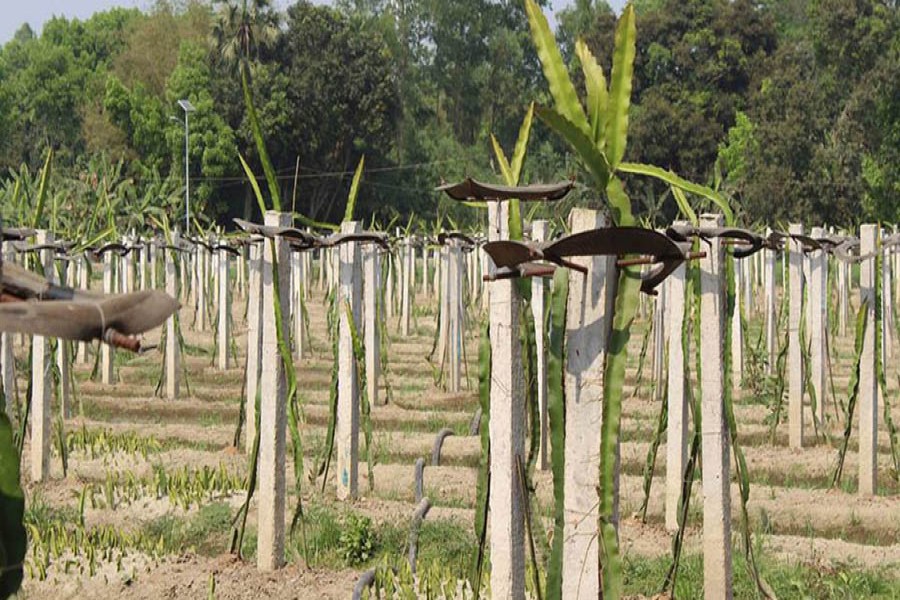NAOGAON, Oct 13: Experimental dragon fruit farming has brought smile on the faces of grassroots farmers in Raninagar upazila of the district this season.
Sources said the fruit cultivation is expanding fast across the district as it is more profitable. Now the peasants of the area have shown more interest to grow the fruit on a large scale.
Farmers said each plant bears around 10 to 15 kg of fresh fruits and some 4, 00 plants can be grown in a bigha of land.
Sources said some farmers have been growing the fruit since 2014 with the assistance of local agriculture offices.
"I have been cultivating dragon fruit on two bighas of land over last three years," said farmer Nazmul Islam of Ranojonia village.
"I have decided to cultivate the fruit commercially", he further said.
Easy cultivation process, low cost and high market price have encourages many unemployed youths to grow the fruit and most of them have attained self-reliance.
Dragon can be harvested within 18 to 20 months after plantation the sapling if the weather condition remains favourable.
Farmer can earn around Tk 0.2 million to Tk 0.3 million from a bigha of land investing around Tk 50,000.
Sub-assistance agriculture officer Bakul Hossain said the region has immense prospect to grow dragon fruit.
"We provide all sorts of input among the farmers to make the farming programme a success", he added.
BSS adds: Farmers are cultivating dragon, a delicious but non-conventional fruit in Bangladesh, along with some other high-valued fruits in Rajshahi region including its vast Barind tract for the last couple of years.
Number of commercial growers of the cash crop is gradually increasing as they are getting lucrative price of their produce in the markets.
Abdul Matin, a farmer of Gofanagar village under Mohadevpur upazila in Naogaon district, has set an instance of becoming successful through dragon farming in the area.
After getting technical support from local horticulture centre, Abdul Matin initiated the farming on August 10, 2016. Already, he has started getting fruit.
Now, there are 50 dragon plants in his orchard. Apart from, he has 65 malta and five orange trees, five lemon, seven papaya, two litchi and three coconut trees as intercropping. On the vacant lands, he has been cultivating turmeric and arum to get additional profit.
Agriculturist Mustafizur Rahman, Additional Director of Department of Agriculture Extension, said prospect of dragon is very much bright in the region including its vast Barind tract as it has started gaining popularity both at farmer and consumer level for its high commercial and nutritional values.
In Rajshahi markets, the high valued fruit is being sold at Tk 550 to Tk 600 per kg while in posh markets of Dhaka it is being sold at Tk 700 to Tk 800. But, the price is beyond purchasing capacity of the commoners.
More than 125 demonstration plots of the cash crop were established in Rajshahi, Natore, Pabna and Bogra districts and the national figure is more than 1,050.
Integrated Quality Horticulture Development Project (IQHDP) of the Department of Agriculture Extension (DAE) is imparting necessary training to the farmers on making the dragon farming more profitable and sustainable.
SM Quamruzzaman, project director of IQHDP, told BSS that there are tremendous prospects of growing dragon fruit in different districts of the country as its topography and environment is suitable for the farming.
He said 43 horticulture centres in 35 districts are extending technical know-how to the farmers and supervising the demonstration plots regularly as the cultivation of dragon fruit is easier than many other crops.
"We have some foreign fruits successfully produced in Bangladesh. Dragon fruit is one of them," said Quamruzzaman. Very recently it was imported to Bangladesh by Germplasm Centre of Bangladesh Agricultural University in Mymensingh and profitably cultivated in some districts.
The plant is nothing but an evergreen cactus, which reaches up to 1.5 to 2.5 metres high with leafless thin vine-like branches. It needs support to hold the vine upward. It reproduces from seeds and from branches (cuttings).
But preferable to grow from branches because growth of dragon plant from seed germination is found to be comparatively slower.
Compost in loamy soil is favourable for growing. Over-watering should be avoided as it may cause fruit-splitting, flower-dropping, yellowing of the plants, and slow shoot development.
Regular mulching around the plants is also important along with providing dynamic lifter and dolomite every alternate month (100 g per plant). The plant blooms only at night, which can affect the process of pollination. In such a case, its growth may be encouraged with the hand pollination technique.

- Sunday, 5 January 2025 |
- Today's FE |
- e-Paper |
- Beta Website

